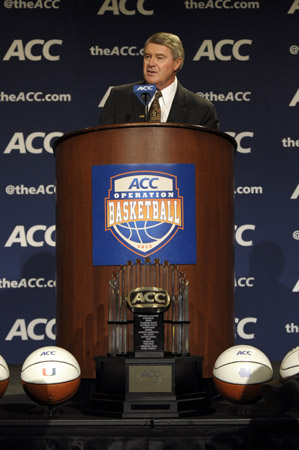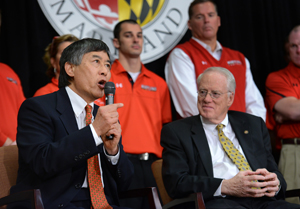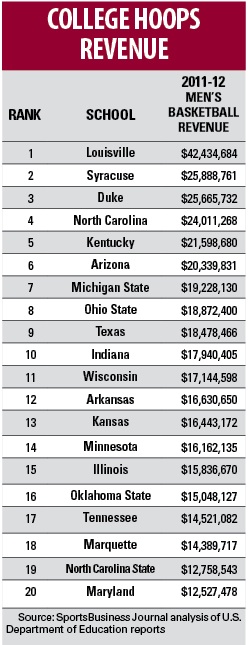ACC Commissioner John Swofford commanded the podium with confidence a few weeks ago when he declared his conference as the most formidable collection of basketball schools ever assembled.
The university presidents in the ACC call him their “quiet leader,” but Swofford, nattily attired in a charcoal suit with his trademark handkerchief in the breast pocket, allowed himself a few uncharacteristic moments of bravado at the microphone during the ACC’s basketball media day.
 |
Swofford speaks to the media during the ACC’s media day for basketball held in Charlotte.
Photo by: USA Today Sports |
{podcast}
SBJ Podcast:
Michael Smith & Tom Stinson
discuss John Swofford and the ACC
Gathered down the hall of the Ritz-Carlton in Charlotte for the first time were Duke’s Mike Krzyzewski, Syracuse’s Jim Boeheim, North Carolina’s Roy Williams, Notre Dame’s Mike Brey, Pittsburgh’s Jamie Dixon and Miami’s Jim Larranaga, some of the nation’s most elite coaches.
They represented an impressive show of force for a conference that just months earlier was mired in realignment hell and unsure of its future.
“There have been times where we might have been perceived as vulnerable,” Swofford said after his news conference that day. “But our league had a vision and the presidents have had the courage to see it through to put the ACC in a position of strength for years to come.”
It was last fall, almost a year ago, that a position of strength seemed unattainable for the ACC. That’s when Maryland, one of the league’s charter members, announced that it would leave its home of 60 years for more handsome paydays in the Big Ten.
What happened in the next six months, with Swofford at the helm, would determine the ACC’s future. Would it retain a position among the five power conferences or would it go the way of the Big East, which ultimately was picked apart by other conferences?
Swofford’s leadership proved to be the hinge, conference presidents say. By adding Louisville and, most importantly, persuading the ACC’s presidents to sign a grant of rights, which conveyed the media rights for all 15 schools to the league through 2027, the ACC’s future was returned to solid ground.
And Swofford, whose stealthy leadership often is underestimated because of his desire to stay behind the scenes, cemented his position as one of the nation’s most influential commissioners for his ability to guide the league through uncertain days.
Swofford has been the ACC’s commissioner for 17 years, but his constituents say he was never better than during those six months when the league’s future swung in the balance.
“All of us were hurt and surprised when Maryland left,” Clemson President James Barker said. “John was equally taken by surprise. But the thing about him is that his leadership stayed the same. He was steady and he was informed, which had a calming effect on everyone. Now we’re in the strongest position we’ve ever been in, and John’s fingerprints are all over it.”
Realignment rumor mill
When Maryland left last November, all bets were off. A trust among the schools had been damaged. The rumors started flying — Florida State and Clemson to the Big 12, North Carolina and Duke to the Big Ten. Georgia Tech, Virginia, they were seemingly all in play.
Most unsettling of all, the rumors about further realignment weren’t just coming from outside the conference. They were coming from inside the league as well.
Athletic directors, trying to protect their own interests, called Swofford to sort out what was Twitter gossip versus
legitimate threats to the league’s membership.
“I’d have ADs or presidents call and say, ‘Hey, you’re going to hear this’ or ‘This is being written and there’s absolutely nothing to it,’” Swofford said. “There also was some, ‘I’m hearing this about another school. Is this true?’ That’s what bothered people. They knew their own situation, but they weren’t always sure about another school.”
Swofford was determined not to be caught by surprise again. He worked the phones in the months afterward, staying in constant contact with university presidents and influential board members.
“During our most challenging times, that’s when he was strongest,” Duke Athletic Director Kevin White said. “John is the consummate leader’s leader. He’s humble and thoughtful and he’s never out of character. There’s not a bit of panic in his DNA.”
White and others identified two game-changing moments earlier this year that helped unify the conference.
The first was an AD-only gathering at the ACC winter meetings last February in Fort Lauderdale, Fla. That’s when Swofford first began building solidarity by espousing his vision for a future together, which included a more robust media contract with ESPN and the potential of an ACC channel.
By this time, Swofford was deep into talks with ESPN to renegotiate the ACC’s media contract, which ultimately rose to $4.2 billion over 14 years.
The next major moment came in March at the ACC tournament, where Swofford gathered ADs and presidents in Greensboro, N.C. That’s when he first presented the structure of a grant of rights and explained how it would work.
If all 15 ACC schools agreed to the grant of rights, it effectively would put an end to realignment rumors. Schools with no media rights theoretically have no value to other conferences. It’s the ultimate commitment to each other and the league.
“You knew that almost any version of conference expansion would involve the ACC, so the grant of rights was the only way to make all of those [realignment] scenarios go away,” Notre Dame AD Jack Swarbrick said.
With the rumors of further realignment swirling, Swofford’s toughest task clearly was keeping everyone on board and unified. His quiet style of leadership was being put to a stern test.
Maryland’s stunner
During his tenure as the ACC’s chief, Swofford, 64, has initiated his share of change. He spearheaded the addition of Boston College, Miami and Virginia Tech 10 years ago on the front end of conference expansion. It was an uncharacteristically messy ordeal that heaped scorn on Swofford for plundering the Big East.
 |
Maryland’s announcement that it was leaving the ACC was something the conference didn’t see coming.
Photo by: Getty Images |
“What I learned was to expect the unexpected,” he said. “And to always insist on confidentiality in your discussions.”
What Swofford never saw coming was one of his schools leaving to go somewhere else. Before Maryland said it would leave last November, an ACC school had never departed for another conference.
Some in the ACC were stunned that Jim Delany, the Big Ten’s commissioner and a North Carolina graduate, would engineer the Terps’ departure. Delany and Swofford overlapped at UNC for three years, Delany playing basketball and Swofford playing football.
Many experts in the industry saw the Maryland move as payback for the ACC’s successful pursuit of Notre Dame, a longtime Big Ten target.
For Delany’s part, he said earlier this year that it was a business transaction, nothing more. It simply moved the Big Ten into new markets, which would help the Big Ten Network generate more revenue. After all, Delany said, wouldn’t it be hypocritical of Swofford to be upset for the Maryland move when the ACC has taken six schools from the Big East?
After the ACC selected Louisville to replace Maryland, the league issued a news release from its presidents in December. The release contained a statement saying that all 15 schools were committed to the ACC.
The snickers could be heard across the land. Nobody bought the words coming from the ACC’s presidents. In a time of tectonic shifts in college sports, such proclamations meant nothing.
Maryland’s leaders had said they were committed to the ACC, too, until they weren’t.
The snarky reaction to what the presidents thought was a very strong statement frustrated them.
“I accepted it and I believed it, but it wasn’t shutting down the [realignment] rumors,” Swofford said. “It made a lot of the presidents mad. They were getting tired of it.”
So Swofford went to work, spending the next four months building consensus for the grant of rights, the only sure-fire way to solidify the ACC’s future.
A grant of solidarity
Swofford, with the aid of media consultant Dean Jordan from Wasserman Media Group and lead ACC counsel Erik Albright, mapped out a plan that would address the potential weak points of a grant of rights.
Swofford had brought up the grant of rights when the ACC raised its exit fee from $20 million to $50 million in September 2012, the same time the Big 12 schools signed their grant of rights. The Pac-12 and Big Ten have similar arrangements within their membership.
“Honestly, we never thought we needed it before,” Swofford said.
 |
The pending arrival of Louisville will further bolster the ACC’s powerful basketball arsenal.
Photo by: Getty Images |
But Swofford saw the way a grant of rights hushed the realignment rumors in the Big 12 and he was hoping it would have the same effect for the ACC.
First, the conference had to make sure the ACC presidents understood the grant of rights well enough legally to explain it to their boards. Swofford sent Albright to meet with attorneys from all 15 schools to show them the actual grant of rights contract and answer questions. The Big 12 shared its own documents so that the ACC could see how it was structured.
“People had to know that John supported this, and that meant a lot to the institutions because they believe in John personally,” Albright said. “They’re betting on John the individual as much as they are the initiative. Everyone knew the long-term benefits of the grant of rights, but we also had some in the conference who were not as far along in their thinking.”
If even one school declined, that would reveal weakness in the league. Florida State was the one that scared everyone. While FSU President Eric Barron had said he supported staying in the ACC, his board had sent mixed signals.
The Seminoles were one of only two schools to vote against the increased exit fees (Maryland was the other). And Andy Haggard, FSU’s board chairman at the time, had been outspoken in his criticism of the ACC’s television deal with ESPN.
Again, Swofford had a plan.
After multiple conversations with Barron, Swofford arranged a two-day visit to Tallahassee on March 6-7 to meet with 11 of the 13 trustees on Florida State’s board, including Haggard, to sell them on the future of the once-vulnerable conference. Swofford, along with Wasserman’s Jordan, met with each trustee individually through the course of the two days. Some meetings lasted 30 minutes, others went close to an hour.
To keep the meetings secret, Swofford had to meet with them one by one to get around a state law that requires public notice for meetings with more than one trustee.
“Those visits have been positioned like a sales pitch, but that wasn’t the case,” Jordan said. “John wanted to answer questions about the ACC’s future, the TV deal, bowl deals, markets. There was so much misinformation out there. John was dialed in to how the league is actually very well-positioned for growth.”
Swofford and Jordan talked casually with each trustee. There wasn’t a PowerPoint or any other visuals, just Swofford’s calming Southern charm and demographic research from Wasserman that showed the assets of the ACC’s footprint, from population to TV households and the recruiting base.
They showed all of the revenue numbers from the rights deal with ESPN and projected what an ACC channel might do for the conference, in terms of both revenue and exposure.
The content of the meetings varied. Some trustees expressed anxiety that Florida State might miss out on the next round of superconference realignment. Others asked about officiating.
“You do what you have to do,” Swofford said. “It was really about sharing all of the opportunities we have in the ACC.”
A week after those March meetings with the FSU trustees, Swofford met with leaders of each school at the ACC basketball tournament and a formal proposal for a grant of rights was put before them on April 19.
Each of the 15 school presidents voted in favor of it, including Florida State.
“The most important part of the whole thing was John’s willingness to sit down with our trustees, even one-on-one, to make sure they understood our future,” Barron said. “As I went back to talk to each trustee, I had their full support to go forward.”
Swofford finally could exhale. The six-month period of uncertainty had run its course and the conference had the solidarity that once seemed so elusive.
A toast for a job well-done
This is the calm after the storm of conference realignment. In the days following the ACC’s grant of rights announcement, Swofford said most commissioners congratulated him for bringing an end to this round of expansion chaos.
Without the ability to cherry-pick schools from the ACC, the other power conferences aren’t as likely to grow into the 16- or 20-team superconferences that had been widely predicted.
The daily rumors of schools jumping from one conference to another have been replaced in the Twitter-sphere by issues like NCAA reform and athlete compensation. Realignment is hardly ever discussed.
“It’s effectively dead,” Swarbrick said.
“There’s been more change in the last five years than the previous 25, and John has managed to not only stabilize the ACC brand, but grow it,” said IMG College President Ben Sutton, a member of Wake Forest University’s board. “And he did it at a time when everyone was writing advance obits for the ACC.”
When the ACC’s highest-ranking constituents gathered for spring meetings in May at Amelia Island, Fla., they celebrated their newfound unity with a dinner in the hotel ballroom. Presidents, ADs, faculty athletic representatives, coaches, bowl representatives and media partners were all there.
As the evening came to a close, Wake Forest’s president unexpectedly went to the podium and asked everyone in the room to raise their glass in a toast to Swofford.
Nathan Hatch thanked the commissioner for his leadership, saying in part, “You’ve been a steady hand during turbulent times. And when the ACC was getting hammered, you stayed the course. We wouldn’t be here without you.”
The 300 or so in the room stood and applauded.
When asked to reminisce about the toast, Swofford smiled and searched for the right words. The normally stoic commissioner allowed his emotions to come to the surface, however briefly.
“It’s something I’ll never forget,” the ACC’s quiet leader said, appropriately, in few words.








